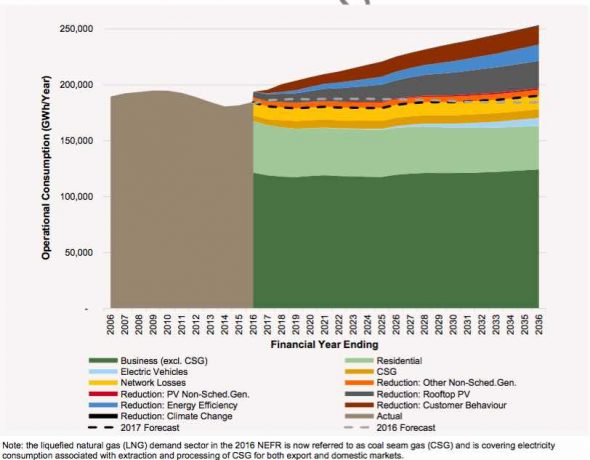 Energy consumers – armed with rooftop solar PV and battery storage – are going to play a critical role in the management of Australia’s grid as it transitions to a low-carbon future, the Australian Energy Market Operator says.
Energy consumers – armed with rooftop solar PV and battery storage – are going to play a critical role in the management of Australia’s grid as it transitions to a low-carbon future, the Australian Energy Market Operator says.
In releasing its new electricity forecast for the next two decades, AEMO says the uptake of solar, storage, demand management and energy efficiency will mean that Australia’s peak demand will keep electricity demand stable for the next two decades, despite a 30 per cent increase in population.
Indeed, the report is dominated by the impact and opportunities of rooftop solar, battery storage and associated technologies and demand controls, and how they are deployed by consumers.
It is a significant shift for AEMO and the energy debate in Australia, which is normally focused on large centralised generation – such as “baseload” coal. But AEMO’s new boss Audrey Zibelman clearly wants to shift the focus to consumers and the demand side of the equation.
This has come as a huge relief for many in the industry who have been advocating for energy efficiency and demand management for years – right back to when Malcolm Turnbull was environment minister a decade ago – but who have met fierce resistance from the generator lobby and energy institutions.
AEMO has looked again at its forecasts and nearly doubled its estimates for the uptake battery storage and now predicts 5.5GW to be installed by households and business to 2037.
It expects a continuing boom with rooftop solar PV – currently being installed at record levels as solar prices drop and grid prices jump – and sees this rising to 20GW, also by 2037.
Zibelman says this will help redefine the grid. Peaks will be pushed into the evening, minimum demand will occur during the day in most states rather than at night, and within 10 years, South Australia will actually have “negative” demand from the grid for a few hours over summer.
All this, Zibelman says, poses challenges to the way the grid is managed. But none of them are insurmountable. Indeed, it presents numerous opportunities for new players, and existing players in the market.
“The energy system is going through a significant transition in how and when consumers use and are supplied energy,” the report says.
“This creates an opportunity for new market arrangements, improved system planning, and new market, network and non-network solutions to support an ‘orderly transition’ and deliver secure, reliable and affordable energy.”
The report says energy consumers are expected to become more active in controlling their energy use, by improving energy efficiency and generating their own energy ‘behind the meter’.
This including businesses, which it notes “are already acting”, clearly taking into account the recent moves by zinc refiner Sun Metals, the vegetable producer Nectar Farms, and Telstra, in sourcing all or part of their energy needs directly through wind and solar.
“The recent spike in rooftop PV installations, and reported actions by large consumers, provide some evidence that many businesses and households are already acting, and this trend is forecast to continue, supported by projected falling costs for PV systems, battery storage, and energy-efficient appliances,” the report says.
This graph above illustrates the important role that rooftop PV, energy efficiency and demand management will play in reducing grid demand. Look above the black dotted line for the developments that reduce demand over the next two decades.
This is consistent with International Energy Agency forecasts of how to meet climate targets, where at least one-third of demand needs to be reduced by demand measures, as the supply side is then cleaned up by the infusion of renewables and dispatchable generation.
Interestingly, Don Harwin, the energy minister in the NSW conservative government, said in a speech on Thursday that the old energy system paradigm “based upon a notion of a baseload of energy demand being supplied by large thermal generators, and then a peak” was changing rapidly.
He agrees with Zibelman that energy efficiency, demand management and clean energy – evidently cheaper than new-build fossil fuels – will play a major role in framing the new markets. “Clean energy has gone from relatively expensive to the cheapest new build technology in a few short years,” Harwin said.
And he pointed to the critical role played by wind and solar and hydro in the heatwave of early February, when the state came close to major shortages, and had to impose load shedding on facilities like the Tomago aluminium smelter.
“Clean energy performed as forecast. Thermal generation did not,” Harwin said.
AEMO sees no problems integrating the huge spike in rooftop solar, given a range of market, network and non network solutions such as storage. These will manage increasing variability with system demand, low daytime demand and increasing “ramping” in morning and evening peaks.
 AEMO also sees an increased uptake in electric vehicles, but only after 2020. It sees the impact of EV charging on grid demand as relatively minor, and less than a switch to electrification in other sectors as they sought to decarbonise and dump expensive fossil fuels.
AEMO also sees an increased uptake in electric vehicles, but only after 2020. It sees the impact of EV charging on grid demand as relatively minor, and less than a switch to electrification in other sectors as they sought to decarbonise and dump expensive fossil fuels.











